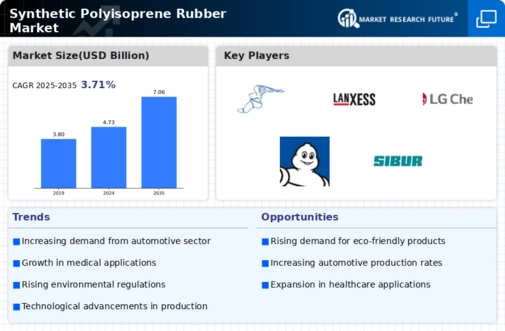Market Growth Projections
The Global Synthetic Polyisoprene Rubber Market Industry is projected to experience substantial growth over the next decade. With an estimated market value of 4.73 USD Billion in 2024, it is expected to reach 7.06 USD Billion by 2035, reflecting a CAGR of 3.71% from 2025 to 2035. This growth trajectory indicates a robust demand across various sectors, including automotive, medical, and consumer goods. The increasing adoption of synthetic polyisoprene in diverse applications highlights its versatility and importance in modern manufacturing. As industries evolve, the market is likely to adapt, presenting opportunities for innovation and expansion.
Rising Demand in Automotive Sector
The Global Synthetic Polyisoprene Rubber Market Industry experiences a notable surge in demand from the automotive sector, driven by the increasing production of tires and rubber components. As vehicles become more advanced, the need for high-performance materials like synthetic polyisoprene is paramount. In 2024, the market is projected to reach 4.73 USD Billion, reflecting the automotive industry's shift towards lightweight and durable materials. This trend is expected to continue, with the market anticipated to grow to 7.06 USD Billion by 2035, indicating a robust compound annual growth rate (CAGR) of 3.71% from 2025 to 2035.
Growing Applications in Medical Devices
The Global Synthetic Polyisoprene Rubber Market Industry finds expanding applications in the medical sector, particularly in the production of medical devices and healthcare products. Synthetic polyisoprene is favored for its biocompatibility and flexibility, making it suitable for items such as gloves, catheters, and seals. The increasing focus on healthcare quality and safety drives the demand for high-performance materials in medical applications. As the global population ages and healthcare needs evolve, the market is poised for growth. This trend underscores the importance of synthetic polyisoprene in meeting stringent regulatory standards while providing reliable solutions in the medical field.
Technological Advancements in Production
Technological innovations in the production processes of synthetic polyisoprene rubber significantly influence the Global Synthetic Polyisoprene Rubber Market Industry. Enhanced manufacturing techniques lead to improved quality and efficiency, reducing production costs while increasing output. For instance, advancements in polymerization processes allow for better control over molecular weight and distribution, resulting in superior material properties. These improvements not only cater to the growing demand but also attract investments in research and development, further propelling market growth. As manufacturers adopt these technologies, the industry is likely to witness a transformation that enhances competitiveness and sustainability.
Market Dynamics and Competitive Landscape
The Global Synthetic Polyisoprene Rubber Market Industry is characterized by dynamic market conditions and a competitive landscape that influences pricing and supply chains. Key players are continuously adapting to changes in consumer preferences and technological advancements, which can lead to fluctuations in market share. Strategic partnerships and collaborations among manufacturers are becoming more common as companies seek to enhance their product offerings and expand their reach. This competitive environment fosters innovation and drives the development of new applications, ensuring that the industry remains responsive to market demands and trends.
Environmental Regulations and Sustainability
The Global Synthetic Polyisoprene Rubber Market Industry is increasingly influenced by stringent environmental regulations and a growing emphasis on sustainability. Manufacturers are under pressure to adopt eco-friendly practices and produce materials that minimize environmental impact. This shift is prompting investments in sustainable production methods and the development of bio-based synthetic polyisoprene alternatives. As consumers become more environmentally conscious, the demand for sustainable products is likely to rise, pushing companies to innovate. This trend not only aligns with regulatory requirements but also enhances brand reputation, potentially leading to increased market share in a competitive landscape.
















